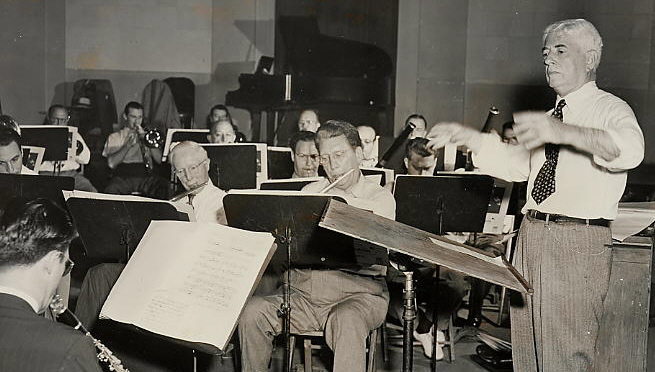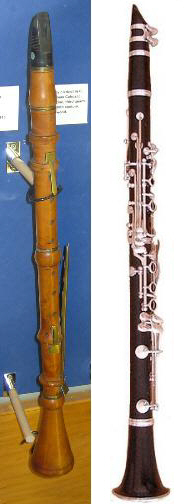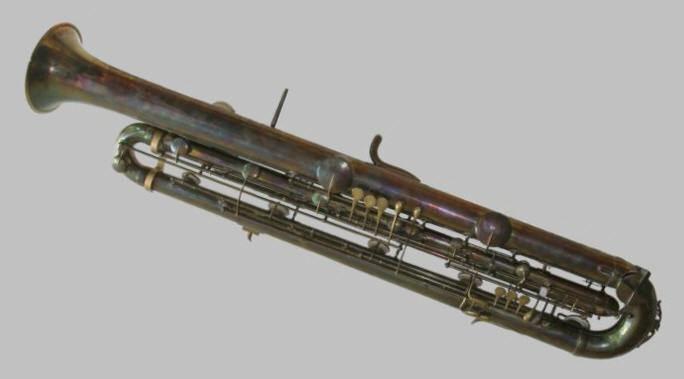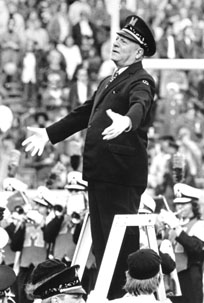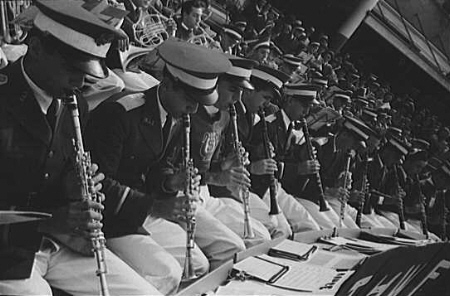11
|
|||||||||||||||||||||||||||||||||||||||||||||||||||||||||||||||
The symphonic band, as it exists today, is a monolithic monster, the unfortunate result of the attempt to equate the symphonic band with the symphony orchestra. As with any type of musical ensemble, the wind band has undergone periods of growth, development, and evolution. Throughout music history, there have been a variety of factors that have affected the size of ensembles, instrumentation and timbre, and literature, both original and transcribed. DIVERSE HISTORY OF INSTRUMENTATIONThe formative years of orchestral music were naturally influenced by the formative years of the instruments that make up the modern orchestra. And, of course they all did not develop at the same time. Interesting studies of this phenomenon and how it has affected composition through the years have been explored through the scholarship of musicians such as Adam Carse and Gardner Reed. The whole concept of melding composition with instrumentation has been studied and compiled by a variety of scholars through the years. Hector Berlioz and Nikolai Rimsky-Korsakov wrote books that are classic studies in orchestration. From its inception in the Baroque opera pit to the contemporary concert stage, the string section has benefited from an earlier maturation than the woodwinds and brass. While the number of wind instruments has fluctuated from one piece to the next, the strings, with their consistent timbre and sheer enormity of numbers, provided a consistency that made them the foundation of the orchestra. By contrast, the identity of the wind band has been more divergent, being influenced by historical period, culture, and composer. This has made a generic description difficult at best. In early 17th century Germany the band might be described as an ensemble of cornettos and sackbuts which signaled the changing of the hour from the tower in the center of town. Or in 18th century England one might refer to Handel's Music for the Royal Fireworks, scored for nine trumpets, nine horns, twenty-four oboes, twelve bassoons, side drums, and three kettle drums. Or consider the United States Marine Band of 1792: this group consisted of two oboes, two clarinets, bassoon, and two horns , an instrumentation based on those military bands found in England and the European continent, and similar to the decidedly non-military Harmoniemusik of Vienna. While the timbre of the 19th century band became more diverse, it also became more consistent, as the instruments were refined to more or less their present state. Due to the efforts of inventors and refiners such as Wilhelm Wieprecht (tuba, baritone), Johanne Stoelzel (valve), Theobald Boehm (flute), Adolph Sax (valve, saxhorn, saxophone), and Hyacinth Klose (clarinet key system), bands could enjoy all the instruments utilized today in a more or less contemporary state of development. In America, from the middle of the nineteenth century through the Civil War, bands were predominantly brass bands, generally consisting of cornets, saxhorns, and drums. Afterward, due to the influence of legendary bandmasters such as Patrick Gilmore, the popularity of the military band rose. In 1878, the instrumentation of the 22nd Regiment Band of New York City, directed by Gilmore, included:
By 1892, Sousa's first professional band (formed after his retirement from the Marine Band) consisted of:
This instrumentation has a startling resemblance to contemporary practice, especially when contrasted to the instrumentation of bands performing many years later such as the 1938 University of Illinois Concert Band:
While acknowledging that the Illinois band is approximately two and one half times the size of the Sousa Band, the timbre possibilities of the Illinois band under A. A. Harding were also more numerous and exotic. Notice the addition of a variety of double reeds, the inclusion of the basset horn and contrabass clarinets, along with the use of fluegel-horns and 3 types of tubas plus string bass. By 1956 Mark Hindsley had dropped the baritone oboe, heckelphone, basset horn, bass saxophone, fluegel-horns, and alto fluegel-horn from the instrumentation.2 - Back to Top -UNITED STATES VS. INTERNATIONAL STANDARDSSince the music of the orchestra has enjoyed international acceptance, the standards of instrumentation are more or less consistent throughout the world. Band repertoire, in contrast, has not enjoyed the same stature. Although standards for instrumentation have been suggested numerous times by various authorities, no common standard has ever been totally achieved. One reason is that band music differs from one country to the next. Since much of the music does not enjoy an international reputation, instrumentation has reflected the styles and customs of individual countries, with less regard for an international market. Music from one country often has to be arranged to fit the accepted instrumentation of another country before it can be performed. This is true both in types of instruments used and in the balance between various sections within the band. The following chart suggests the wide variety of instruments available to the contemporary concert band:
Typically, not every country has used all the wind instruments potentially available. For instance, writing in the Music Journal Annual in 1962, William Revelli explained that French and Italian bands use the complete family of saxhorns, providing a full spectrum of conical brass sound not found in British and American bands, which usually employ only the baritone and bass horns. In contrast to American bands, British bands emphasize cornets over trumpets. The bassoon is fundamental in English and German bands while American bands frequently double or supplant the bassoon with the saxophone. E-flat soprano clarinet and soprano saxophone are staples of the French and Italian bands not always accepted in American bands.3 Balance between woodwinds and brass also differs from one country to the next. This is a direct reflection of past history, arrangers, publishers, composers, and individual directors. William Revelli described the balance as follows: Germany advocates one-third woodwinds; France and Italy recommend one-half woodwinds, including saxophones; English bands are approximately one-half woodwinds; America recommends two-thirds woodwinds for concert bands, with the reverse for military or gridiron and parade bands. Revelli continues: The French and Italian bands maintain two separate and complete brass sections; hence, the woodwind sections must be augmented in order to balance the instrumentation properly. If sufficient woodwinds are not available, the brasses predominate, as they frequently do in all such instrumented groups.4 The result is that at times composers have been frustrated by the lack of standards, concerned that there would be a wide disparity in performances of their music. Today, with the growing international market for wind band literature, the disparity is not as great, though some European publishers still provide extra parts to fit the demands of divergent instrumentations. - Back to Top -PROBLEMS IN INSTRUMENTATION AND BANDSTRATIONOne weakness in instrumentation has been the inherent doubling which thickens the quality of the band sound. The prevalent attitude in school bands in the past has seemed to be that everyone should play as much of the time as possible so at to not become bored. Thus many opaque sounds are destroyed by the addition of unlike voices playing the same line. All too frequently tenor sax, bass clarinet, and baritone horn played essentially the same part--or one finds that the 3rd B-flat clarinet, alto clarinet, and alto sax doubled what could have been a solo line for alto clarinet or alto saxophone. This emphasis in the middle register de-emphasizes the potential for the upper and lower registers--areas that often lack adequate personnel, such as piccolo and E-flat soprano clarinet, or bassoon and contra-alto or contrabass clarinet. On occasion some instrument families are missing from the color spectrum, such as the frequently absent double reeds. Another problem is incomplete sections. Few bands utilize the full clarinet or saxophone section from soprano to contrabass voices, for example. Since instrumentation and bandstration are by necessity integrally meshed in the creative process, some advocate that instrumentation should be the composer's prerogative so as not to limit the creative process.5 In fact, Gustav Holst, considering the study of orchestration to be an artificial exercise, made the following comment concerning Berlioz' concept of orchestration: Orchestration? What do you mean? That's a question I cannot answer. You see, I'm not able to dissociate orchestration from the material which is being orchestrated. So Berlioz is no good to me. Once I tried to teach orchestration at the College (Royal College of Music), but I found it was impossible. The whole thing goes together, the material indicating the orchestration. If a drawing is bad, you can't show a student how to colour it.6 Obviously composers have to work within some pragmatic bounds, but to allow no additions or subtractions from instrumentation, or to insert certain doubling (such as resulted when Holst's Suite in E-flat arrived in America) is frustrating to a composer and potentially compromises the music's original intent. - Back to Top -INSTRUMENTATION AND THE NATIONAL SCHOOL BAND CONTESTIn the United States, instrumentation was particularly inconsistent in early school bands. After the initial National School Band Contest in 1923, discussion ensued during subsequent years to address this problem so as to provide a working standard for all band programs interested in entering the contest. In 1927 the School Band Contests booklet listed the following acceptable instrumentation for a 68-piece band:
Promoting SaxophonesAmerican instrument manufacturers were ardent in their preference for bands make up of a majority of saxophones. As evidence of their tenacity, a 100-piece professional saxophone band, financed by the manufacturers, performed at the Music Educators National Convention in Chicago in 1928. Given his devotion to the saxophone, one wonders what Percy Grainger would have thought of such a performance!1It was the committee's intention to replace the strings of the orchestra with a full complement of clarinets. This seemed appropriate due to the wide pitch range which is accessible and the perception that clarinets could play for longer periods of time with less fatigue than some other instrument families.7 This instrumentation met opposition not only from directors, but also from school administrators, instrument manufacturers, and music publishers. Although the committee held its ground, it secured the additional services of John Philip Sousa, Frederick A. Stock, Edwin Franco Goldman, Captain Taylor Branson (U. S. Marine Band director), and Herbert L. Clarke to work out a standard instrumentation to be published in the 1928 edition of State and National School Band Contests. The result was fundamentally the same as the previous year's, with the exception of allowing a slightly larger number of players and slightly enhancing the flexibility of numbers within sections. The 1928 booklet further allowed: 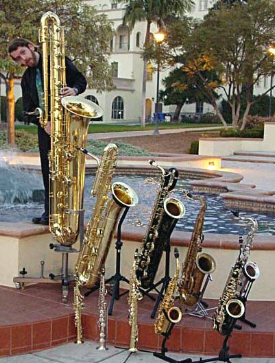 Jay C. Easton with saxophones: contrabass, bass, baritone, tenor, C tenor, alto, F mezzo-soprano, soprano, C soprano, sopranino 6 Large bands may double the number of saxophones. Additional instruments suggested for special effects or for additions to large bands: Harp, contra-bassoon, sarrusophone, 2 string basses, heckelphone, alto flute, E-flat trumpet, tenor horns . . . It is the desire of the Committee to encourage experimentation in instrumentation by large and well-developed bands in the hope that the above standard may be improved in the future, and for this reason no band will be penalized for "overinstrumentation" either as it applies to sections or additional instruments.8 School band directors were concerned by the demand for alto and bass clarinet players, citing the inability of such players ever to find professional employment. School administrators cited the Committee as being in camp with the manufacturers by creating a market for the sale of more instruments. Instrument manufacturers felt the Committee was de-emphasizing those instruments that were the moneymakers in regard to sales - cornets and saxophones. They felt that by limiting the number of these two instruments, while supposedly promoting the use of clarinets, bassoons, oboes, low clarinets, and French horns that were primarily of European manufacture, they were put at an unfair disadvantage. Eventually, manufacturers began to make those instruments previously made only in Europe, but not without protest. They would have preferred that the new instrumentation consist of up to fifty percent saxophones, but had to settle for the clause, which only allowed their numbers to be doubled! Music publishers were concerned that their entire catalogues would be rendered obsolete. Their argument was not unfounded. Music catalogues of the early 1920s listed the following instrumentation as standard for military band:9
Publishers demanded the Committee draw up instrumentation that would fit existing publications. Meanwhile new publishers using the prescribed guidelines provided the needed literature to bide the time until the established publishers gave in to progress. Had the instrument manufacturers and more established music publishers had their way today's wind band movement might have a radically different appearance. - Back to Top -THE CLARINET CHOIREvery few years someone rediscovers, then publishes in a journal, the "novel" idea that the key to effective band instrumentation is to create a clarinet choir as substitute for the strings of the orchestra. In the United States the idea was practiced in the professional bands of the late 19th century and early 20th century (refer to Sousa's instrumentation as one example). This approach was pragmatic, since the bulk of the early repertoire came from orchestral literature. The Committee focused on this matter when considering instrumentation for the National School Band Contest. A clarinet section as a substitute for the string section created two concerns. First, there must be a large enough number of clarinets to provide a dominant sound, and second, a full complement from at least the E-flat soprano down to the B-flat contrabass is necessary to allow for a full harmonic spectrum. Through the years noted experts in bandstration such as Alfred Reed and Lucien Calliet have advocated this method both in print and in personal practice. At least two elements have kept this from becoming a universally pervasive practice. First, many advocates of the wind band maintain that this practice sets up the band to function as an inferior copy of the orchestra. Consequently, while desiring a full pitch complement from high to low, composers and conductors may not want the clarinets to be the dominant sound in the band. Others have argued that the E-flat soprano is hard to tune, and that the E-flat alto is an inferior instrument both in pitch and tone quality. The rationale continues that since flutes and saxophones already cover these two registers, these particular clarinets are unnecessary. As a result, the strength of the wind band is that in lieu of a single dominant color (as in the orchestra) there are several choirs within the tonal picture. The second concern focuses on the repertoire written for orchestral winds, which is similar to a band without saxophones and euphoniums. This literature, substantial as it may be, cannot always be adapted for the concert band. This resulted in the formation of the Eastman Wind Ensemble by Frederick Fennell in 1952. Fennell created an ensemble with mostly one player to a part, and flexible instrumentation that allowed him to play both the literature of the wind band and the orchestral winds. It also gave the wind band an opaque quality in which individual timbres were not covered up by excessive doubling. - Back to Top -WIND ENSEMBLE VS. SYMPHONIC BANDEver since its inception, conductors and composers have argued the merits of the wind ensemble vs. the symphonic band. One concern is the doubling of parts. The elimination of doubling creates added clarity and precision. Also, when fewer parts are doubled, individual timbres project, in contrast to larger ensembles with a more homogeneous sound. Some pieces, such as Stravinsky's Symphonies of Wind Instruments written for wind ensemble or chamber winds, are best left alone. Lincolnshire Posey, while having been played successfully by groups of many different sizes, understandably takes on different qualities when played by a group of forty as opposed to a group of seventy or ninety. Balance becomes a factor when solo parts within the music have to play above a large ensemble. On the other hand, George Washington Bridge by William Schuman takes on striking differences when played by a large, rather than small, ensemble. The dissonance so common throughout the work takes on an edgy, almost brittle quality when played by a smaller group, while a large ensemble provides a depth of sonority establishing a quality of strength and foundation. The symphonic band also has the added advantage of greater dynamic contrast. An eighty-piece band playing a true pianissimo is a breathtaking experience. On the other hand, the wind ensemble has the jump on precision. Three trumpets playing a fast articulation, or three clarinets playing a demanding melodic sequence will play with more coordination than nine or twelve players trying to play in unison. Since there are advantages to both, ultimately the decision as to which size of ensemble is more acceptable has been largely a matter of taste. Unfortunately, a bit of snobbery has been manifested on both sides of this argument, which has not served the cause of music education. Increasingly, flexibility has become the order of the day, allowing each director to promote the composer's true intent no matter what size ensemble is used. CONCLUSIONFinally, because a reasoned approach to instrumentation and bandstration has been increasingly adopted, the aesthetic potential for the wind band is stronger than ever. Composers have demonstrated that the power and sonority of the wind band is not an element of composition that needs to be over-emphasized to the detriment of musical taste. Compositions with continual, massive, homogeneous sounds have been increasingly replaced by works that provide variety through solo and small ensemble passages, and that promote opportunities for more imaginative color groupings, contrast in mood, and melodic development. Also, by limiting the amount of doubling, players are provided the opportunity to rest, which, in time, allows them to regain their endurance, especially in overly demanding works. The color possibilities of the band, when compared to the orchestra, are limited only by the absence of the string section. Despite the lack of this fundamental sound of the orchestra, the wind band compensates with possibilities not regularly available to the orchestra. The orchestra generally does not use a full component of clarinets, while the saxophone family and the euphonium are seldom used. In the band, however, the general enlargement of flute, clarinet, and trumpet sections allows for harmonic possibilities within one timbre not possible in the generic orchestral instrumentation. This provides adequate power for a section not only to carry the melodic line above the rest of the ensemble, but also allows for harmonic support within the same section. With careful use of all sections it has become possible for the band to include not only a powerful sound, but also to escape the stereotype of a thick, dull homogeneous sound for one of clarity, refinement, and grace. During the 20th century eminent composers have written many new works for the wind band that fit these criteria. The result is a sophistication of sound both exciting and intriguing. - Back to Top -
|
|||||||||||||||||||||||||||||||||||||||||||||||||||||||||||||||
